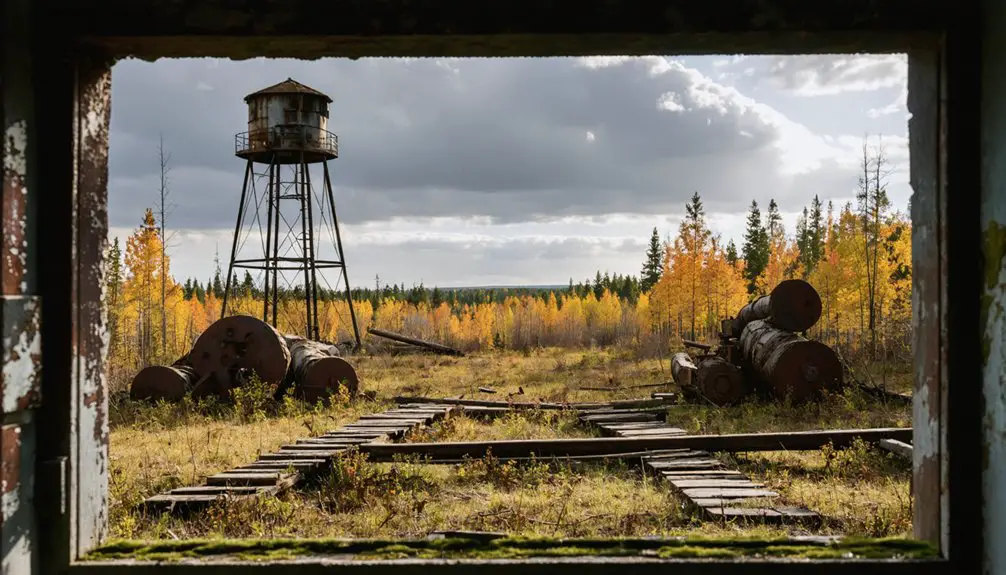You’ll find Wekwagamaw nestled in Michigan’s Keweenaw Peninsula, where it emerged during America’s first mineral rush following Douglass Houghton’s 1840 copper discovery. The town quickly developed into a bustling mining community, supporting over 30 nationalities of workers who braved dangerous conditions in the copper mines. While the mines generated wealth surpassing California’s Gold Rush, the late 1800s brought decline as copper veins depleted, transforming this once-prosperous settlement into an intriguing representation of Michigan’s mining heritage.
Key Takeaways
- Wekwagamaw transformed from a bustling copper mining town to a ghost town following resource depletion and mine closures in the late 1800s.
- Over 30 nationalities populated the town during its peak, leaving behind abandoned company housing, schools, and hospitals.
- The town’s decline accelerated after railway station closure, which severed vital transportation links for remaining residents.
- Located in Michigan’s Keweenaw Peninsula, Wekwagamaw was part of America’s first mineral rush following the 1840 copper discovery.
- Social establishments like churches and ethnic societies were abandoned as miners and families left, leaving cultural remnants behind.
Historical Significance and Discovery
How did a small Upper Peninsula settlement become one of Michigan’s most intriguing ghost towns?
You’ll find Wekwagamaw’s origins deeply rooted in America’s first mineral rush, sparked by Douglass Houghton’s momentous copper discovery in 1840. This breakthrough transformed Michigan’s Upper Peninsula into a bustling frontier of opportunity.
The town formation followed a familiar pattern you’ll recognize across Michigan’s mining history – prospectors and settlers flocked to promising sites, establishing communities around valuable copper deposits. The resource depletion eventually led to the town’s abandonment, following the pattern of many mining settlements in Michigan.
Like many of its neighboring settlements, Wekwagamaw emerged as part of this copper boom, with its future tied directly to the region’s rich mineral wealth. Similar to the town of Phoenix, which became home to St. Mary’s Church in 1858, the town quickly developed into a functional community, complete with the essential services needed to support the brave souls who ventured north seeking their fortunes.
Life in the Mining Community
While copper mining promised wealth and opportunity, daily life in Wekwagamaw demanded tremendous sacrifice from its workers and their families.
You’d find a diverse workforce of over 30 nationalities laboring in dangerous conditions, where one miner died weekly from accidents, and injuries like blindness were common.
Community dynamics centered around company-provided housing, schools, and hospitals, while local businesses thrived serving mining families.
Underground, you’d work intense physical jobs in warm mines despite harsh Michigan winters.
Miners worked under a contract-based system imported by experienced Cornish miners who had left failing mines in Cornwall.
Labor relations grew tense as workers fought for better conditions, culminating in the 1913-1914 strike when miners demanded safer practices and fair wages.
Though companies opposed unions fiercely, bringing in the National Guard, the strike marked a turning point in workers’ rights throughout the region.
Young boys often joined the workforce performing unskilled labor, though women never worked in the mines.
Economic Rise and Decline
You’ll find that Wekwagamaw’s meteoric rise began when copper deposits transformed this Upper Peninsula settlement into a bustling mining center that outpaced even California’s Gold Rush wealth generation.
Mining operations began in the early 1840s, predating the California Gold Rush.
The one-industry economy ultimately made the town vulnerable to market fluctuations and downturns.
As mining operations expanded through the mid-19th century, the town developed a robust financial infrastructure with general stores, hotels, and services catering to the surge of immigrant workers and their families.
The eventual depletion of economically viable copper deposits, combined with plummeting global copper prices, triggered a mass exodus that left abandoned buildings and shuttered businesses in its wake.
Mining Boom Takes Hold
Since the discovery of Michigan’s first commercial copper mine in 1771, the Keweenaw Peninsula transformed into a mineral powerhouse that would shape the region’s destiny for over a century.
Douglas Houghton’s detailed geological reports sparked speculative activity in 1841, drawing eager investors and miners to the promising copper-rich territory.
As copper discoveries multiplied in the 1840s, you’d have witnessed thousands of prospectors flooding the area, all seeking their fortune in the rich mineral deposits.
Mining techniques evolved rapidly with the introduction of steam-powered equipment for rock stamping and water pumping, making operations more efficient and profitable.
The opening of the St. Mary’s Falls Ship Canal in 1855 revolutionized mineral transport, connecting the region’s wealth to distant markets.
Major mining operations like Quincy and Cliff Mine emerged as dominant employers, while consolidated companies like Calumet and Hecla began controlling most of the region’s copper production, forever changing the economic landscape of the Keweenaw Peninsula.
The region’s unique geology yielded pure native copper, unlike most other mining regions that contained copper oxides or sulfides.
Resource Depletion Forces Exodus
The prosperous mining era of Wekwagamaw began to unravel in the late 1800s as copper veins showed signs of depletion.
You’d have witnessed the town’s struggle for economic adaptation as extraction costs soared and profits plummeted. Despite the community’s resilience, the mining company couldn’t sustain operations once rich copper deposits were exhausted, forcing widespread closures that triggered a mass exodus of workers and their families.
- Local businesses shuttered as population declined, creating a downward spiral of reduced services.
- Working-age residents left first, seeking opportunities in more vibrant economic regions.
- The railway station’s closure cut off crucial transportation links, further isolating the remaining inhabitants.
Without its economic backbone, Wekwagamaw couldn’t maintain essential infrastructure, and the once-bustling streets fell silent as buildings were abandoned. The last remnants of the mining industry disappeared when the five stamp mills between Freedom and Red Ridge finally ceased operations.
Financial Infrastructure Collapses
As copper production faltered in Wekwagamaw during the late 1800s, local banks and financial institutions began a rapid retreat from the region.
You’d have witnessed the domino effect as credit scarcity crippled businesses that once thrived on miners’ wages. Local merchants couldn’t secure loans to keep their doors open, while mining companies defaulted on their obligations.
The town’s financial mismanagement became evident as tax revenues plummeted. Much like Central Mine’s historic 44-year operational run, the town’s economic vitality proved unsustainable in the long term.
You’d have seen essential services crumble – schools closing, roads deteriorating, and fire stations shuttering. Global copper market shifts dealt the final blow, making Wekwagamaw’s mines unprofitable.
When the major mining operations declared bankruptcy, they left behind unpaid wages and a workforce with nowhere to turn.
The town’s financial infrastructure, once robust, completely disintegrated.
Natural Resources and Industrial Impact

In Wekwagamaw, you’ll find the remnants of copper mining shafts that once employed over 2,000 workers during the region’s peak extraction period between 1865-1890.
The town’s industrial footprint expanded when the Northern Michigan Timber Company established operations in 1872, constructing a sawmill that processed white pine from the surrounding forests.
The combined decline of copper deposits and timber resources by 1915 triggered the town’s ultimate abandonment, leaving behind the weathered ruins of mine structures and mill foundations that you can still explore today.
Mining Operations Overview
Located within Michigan’s mineral-rich Keweenaw Peninsula, Wekwagamaw’s mining operations centered on massive copper deposits formed 1.1 billion years ago in ancient volcanic rocks.
You’ll find that mining techniques evolved from simple pit extraction to sophisticated shaft mining, as companies like Quincy Mining Company invested heavily in exploration and infrastructure development.
The region’s distinctive native copper deposits required specialized extraction methods, while labor disputes shaped the industry’s development, particularly during the landmark 1913-1914 strike.
- Advanced shaft sinking methods targeted both fissure veins and longer-lasting conglomerate lodes
- Two-man drill teams worked the depths, extracting valuable native copper ore
- Company towns sprouted around mine sites, providing housing and essential services for hundreds of workers
Timber Industry Expansion
Three major white pine forest belts surrounded Wekwagamaw during Michigan’s lumber boom of the 1840s-1900s, making the town a strategic hub for timber operations.
You’d have witnessed massive white pines, some towering over 200 feet, being felled and transported through an intricate network of waterways. Local logging crews used oxen teams for skidding logs to riverbanks, where they’d mark each log before spring floods carried them downstream to sawmills.
As you’d explore the area today, you’ll find evidence of timber transportation infrastructure that transformed Wekwagamaw into a bustling center.
The logging techniques they used, from high-grading prime white pine stands to using dynamite for clearing log jams, reshaped the landscape. While the industry brought temporary wealth, it ultimately stripped the region’s virgin forests bare.
Resource Depletion Effects
When Michigan’s mining boom reached its peak in the late 1800s, Wekwagamaw’s fate became inextricably linked to the finite nature of its mineral wealth. The town’s poor resource management led to rapid depletion of copper and iron ore deposits, triggering a devastating chain reaction.
You’d have seen mines that once produced tons of minerals gradually becoming unprofitable, forcing closures and eliminating jobs that sustained the local economy.
- Mining infrastructure fell into disrepair as operations ceased, leaving abandoned shafts and equipment scattered across the landscape.
- Transport routes shifted away from the declining town, isolating remaining businesses and reducing community resilience.
- Environmental degradation from mining runoff and debris made the land unsuitable for alternative industries, accelerating the town’s transformation into a ghost town.
Geographic Features and Climate
The rugged terrain of Wekwagamaw lies within Michigan’s Upper Peninsula, a region carved by ancient glaciers and defined by the Superior Upland’s crystalline bedrock.
You’ll find dramatic geological formations of Lower Silurian sandstones and limestones, with significant mineral deposits scattered across the rocky landscape.
The area’s climatic patterns are heavily influenced by the surrounding Great Lakes, particularly Lake Superior to the north and Lake Michigan to the south.
Weather in this region dances to the rhythm of Lake Superior and Lake Michigan, twin forces shaping the local climate.
You’re never more than 6 miles from a natural water source here, where lake-effect snow blankets the region during long winters.
While summers remain relatively cool and brief, the surrounding waters moderate temperatures year-round.
The combination of ancient lava flows, glacial moraines, and over 1,700 miles of shoreline creates a uniquely rugged wilderness.
Cultural Heritage and Social Fabric
As mining opportunities drew waves of immigrants to Wekwagamaw in the late 19th century, a rich tapestry of cultural diversity emerged among its residents.
Cornish, Finnish, Italian, and Irish workers brought their cultural traditions, creating a vibrant community where churches and social halls became centers of cultural expression and community cohesion.
You’ll discover how these immigrant groups shaped Wekwagamaw’s identity through:
- Social clubs and ethnic societies that provided mutual aid while preserving heritage
- Churches that served as anchors for cultural identity and community gatherings
- Local celebrations and customs that blended different ethnic traditions
Life in Wekwagamaw revolved around the mining industry’s rhythms, with prosperity enabling a thriving social scene.
Though the town’s decline led to eventual abandonment, its cultural legacy lives on through oral histories and stories passed down by descendants of these diverse mining families.
Preservation Efforts and Tourist Appeal
Despite its abandoned status, Wekwagamaw’s historical significance has sparked coordinated preservation efforts between local historical societies and Michigan’s Department of Natural Resources.
Modern preservation techniques include digital archiving through apps like Keweenaw Time Traveler, while strategic signage and pathways protect sensitive areas from visitor impact.
Tourism strategies focus on highlighting the site’s copper mining heritage and scenic Lake Superior location. You’ll find parking areas, marked trails, and informational plaques that enhance your exploration while safeguarding fragile structures.
Local organizations offer seasonal guided tours, though winter weather can limit access. The site’s proximity to museums and interpretive centers adds educational value to your visit.
While vandalism and structural decay pose ongoing challenges, collaboration with private landowners guarantees you can responsibly experience this piece of Michigan’s mining history.
Archaeological Evidence and Research Findings
Located in Michigan’s Upper Peninsula, Wekwagamaw’s archaeological remnants paint a vivid picture of 19th-century copper mining life through carefully preserved house foundations, industrial ruins, and cemetery plots.
Modern archaeological techniques have revealed a wealth of artifacts, from broken pottery to mining equipment, telling the story of a once-thriving community that peaked at over 700 residents. Through meticulous artifact analysis, researchers have uncovered evidence of diverse immigrant populations and their daily lives.
- Metal detection surveys have exposed mining tools and copper remnants, showcasing industrial practices
- Excavated pottery fragments demonstrate trade networks and domestic life patterns
- Cemetery markers provide demographic data and cultural insights into the immigrant community’s composition
The site’s marshy conditions challenge preservation efforts, but careful stratigraphic excavation continues to yield valuable historical data about this abandoned mining settlement.
Frequently Asked Questions
What Indigenous Tribes Originally Inhabited the Wekwagamaw Area?
You’ll find the area’s rich Anishinaabe heritage primarily through the Ojibwe, Odawa, and Potawatomi peoples, who formed the Three Fires Confederacy, sharing deep Ojibwa cultural traditions across the region.
Are There Any Documented Paranormal Activities or Ghost Sightings in Wekwagamaw?
Despite dozens of Michigan ghost towns reporting ghostly encounters, you won’t find documented paranormal investigations or verified spirit sightings in Wekwagamaw’s historical record. The area’s supernatural status remains unexplored.
Can Visitors Legally Collect Minerals or Artifacts From Wekwagamaw?
You can’t legally collect minerals or artifacts without proper permits and permissions. Mineral collection and artifact preservation laws protect these historical sites, requiring authorization from landowners or governing authorities.
Which Prominent Mining Families Owned Property in Wekwagamaw?
While 75% of copper mining properties in Michigan’s Keweenaw Peninsula were corporate-owned, you’ll find Wekwagamaw’s property ownership was split between Cornish mining families and the Quincy Mining Company’s controlling interests.
What Transportation Routes Connected Wekwagamaw to Other Upper Peninsula Settlements?
You’ll find the settlement connections involved logging roads, wagon trails, and the DSS&A railway network, which linked remote areas through seasonal routes to major U.P. hubs like Sault Ste. Marie and Houghton.
References
- https://www.visitkeweenaw.com/blog/post/our-top-7-keweenaw-ghost-towns-to-explore/
- https://kids.kiddle.co/List_of_ghost_towns_in_Michigan
- https://www.visitkeweenaw.com/things-to-do/museums-history/ghost-towns/
- https://www.smithsonianmag.com/history/once-a-year-this-19th-century-michigan-ghost-town-comes-to-life-180982695/
- https://www.youtube.com/watch?v=YYm9FXZ4mCk
- https://gandernewsroom.com/2023/06/28/7-michigan-ghost-towns-you-might-not-find-on-your-map-2/
- https://npshistory.com/publications/kewe/index.htm
- https://en.wikipedia.org/wiki/Copper_Country_strike_of_1913–1914
- http://www.minsocam.org/msa/collectors_corner/vft/mi3d.htm
- https://www.nps.gov/kewe/learn/historyculture/copper-mining-timeline.htm


